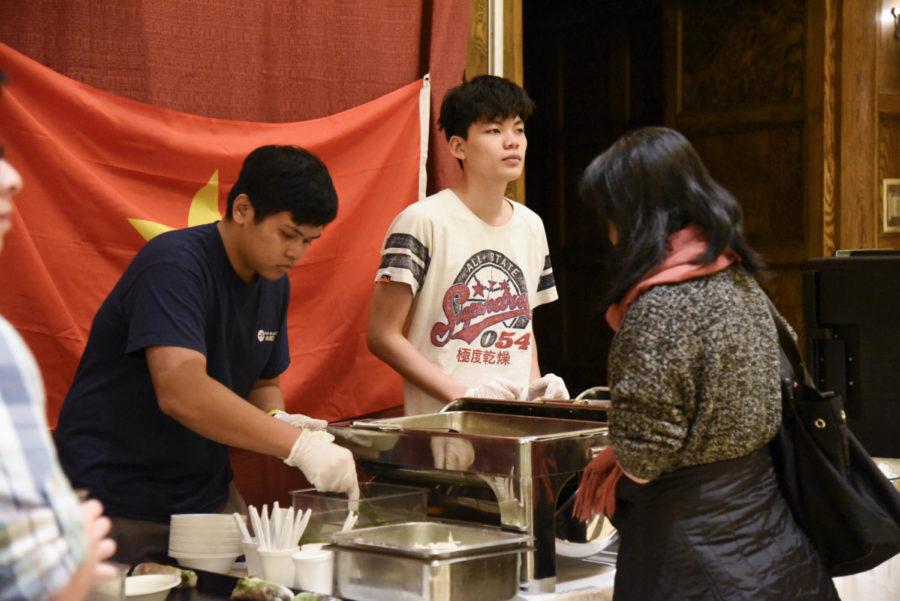World cuisine event expands taste palates with international foods
November 10, 2019
Drawn by the smell of food, hundreds of people packed into the South Ballroom of the Memorial Union on Sunday for “World Cuisine — Around the World in 30 Dishes.”
World Cuisine is the first event of International Week at Iowa State and had plenty of attendees, including Iowa State students, faculty, staff and Ames community members.
“I’m new to International Student Council, so the planning was a lot of learning from past members,” said Alejandra Flores, sophomore in political science and history and organizer of the event. “I have been to the event before but had never organized it. It was a lot of contacting catering, event planning and getting the space. The groups actually cook all their own food, so there is a lot of preparation to get it here.”
As attendees entered the South Ballroom they were greeted with booths that sold food coupons for $0.50 each. These coupons allowed attendees to purchase a variety of foods at different booths, with different food items costing a different amount of tickets.
All the funds gained from the event are allocated to the International Student Council Scholarships to help international students at Iowa State in financial need, who contributed to the international community, according to the event press release.
There were 11 different student groups with booths at the event, each with a flag representing the country they are from and multiple different food items from that country.
The Asian Student Union had three food items, which included pork dumplings, almond cookies and mango lassi.
Mango lassi is a traditional mango and yogurt-based drink that originated in the Indian subcontinent, according to cookwithmanali.com.
“Today we are here serving pork dumplings, almond cookies and mango lassi,” said Jasmine Luangdetmalay, president of the Asian Student Union and a senior in finance. “Since the Asian Student Union revolves around a bunch of different cultures and ethnicities, our food options are pretty diverse. The pork dumplings are from the Chinese side of the cuisine; it represents longevity and long life. The almond cookies are a common dessert that is pretty popular, found among Asian cultures. The mango lassi is a common South Asian drink.”
The Filipino-American Association had two food items, which were turon and puto cupcakes.
Turon is a Philippines snack made of thinly sliced bananas that are dusted with brown sugar, rolled in a spring roll wrapper and fried, according to panlasangpinoy.com.
The group said they were raising funds at their booth to send to those in need after the recent 6.5 magnitude earthquake, which killed at least 14 people, according to CNN.
The Filipino Student Association’s food items included halo halo and arrozcaldo.
Halo halo is a Filipino cold dessert that is a concoction of crushed ice, evaporated milk and various other ingredients, according to foodnetwork.com.
“We are kind of a new organization, so we want to get our name out there,” said Ralph Rapanut, junior in civil engineering. “I feel like the best way to get our name out there is with food. The Philippines is known for its food and we just wanted to bring the food to other people here.”
The French Club had two food items which included crepes and hot chocolate.
A crepe is a type of very thin pancake, according to foodnetwork.com.
“We are serving crepes with a variety of toppings, so bananas, strawberries and Nutella, and we are also serving hot chocolate, which was made from scratch,” said Taline Jouzi, president of French Club and a sophomore in pre-diet and exercise.
The Taiwanese Student Association had two food items, which were bubble tea and lu rou fan.
Lu rou fan is a Taiwanese dish consisting of braised minced pork over rice, according to thewoksoflife.com.
“We are serving pork stew with rice,” said Jen-Ni Lin, junior in architecture. “We are Taiwanese; the dish is from China, but is one of our special dishes.”
The Indonesian Student Association had two food items, which included chicken satay and crispy tofu.
Chicken satay is a chicken skewer marinated in a peanut-y sauce, and then grilled, according to allrecipies.com.
“We are selling chicken satay and crispy tofu this semester for the International Food Fair,” said Nicholas Wijaya, senior in aerospace engineering. “We sell this every year and we know the chicken satay is a hit every time; that is why we keep coming back with the chicken satay. People come back every time for us. This is the first time we are selling the crispy tofu, which we did so that people could enjoy something without any restrictions.”
The Vietnamese Student Association had three food items, which included vietnamese chicken wings, Che Thai and Vietnamese iced coffee.
Che Thai is a Vietnamese riff on a popular Thai sweet snack called tap tim krop that features pomegranate juice, water chestnuts, tapioca and coconut milk, according to vietworldkitchen.com.
“We are selling Vietnamese chicken wings, Vietnamese coffee and a Vietnamese desert called Che Tai,” said Tran Nguyen, senior in criminal justice. “The Che Tai is not a staple but is really common. The Vietnamese coffee is really popular, so we brought that back and the chicken wings are a new thing that we did this year.”
The Vietnamese International Student Association had three food items, which included pho, spring rolls and peach tea.
Pho is a Vietnamese soup consisting of broth, rice noodles, herbs and meat, according to foodrepublic.com.
“We are doing pho, which I think is the most famous Vietnamese dish,” said Hoang Dang, junior in electrical engineering. “We are doing a slightly different version of it, which is chicken pho with two types of noodles — wider ones and smaller ones. We tend to us the wider ones in Vietnam.”
The Malaysian Student Association had two food items, which were chicken satay and halal chicken noodle soup.
Halal is an Arabic word that means “permissible,” according to thekitchn.com. In terms of food, it means food that is permissible according to Islamic law. For a meat to be certified halal, it cannot be a forbidden cut, such as meat from hindquarters, or animal, such as pork.
“We are here to promote our Malaysian culture and we also want to meet a lot of new people,” said Mike Shau, junior in mechanical engineering. “I am having a lot of fun. We are serving chicken satay and chicken noodle soup.”
The Korean Student Association had two food items, which were spicy rice cakes and spam mayo rice balls.
The spicy rice cakes are popular Korean street foods in Korea, according to mykoreankitchen.com.
“We are selling our food but also exchanging our culture,” said Daniel Sea, sophomore in marketing. “We cooked two traditional foods, one is a very authentic food and the other is more of street food.”
Sankalp had four food items, which included butter chicken, falooda, veggie cutlet and rice.
Falooda is a cold dessert with origins in the Indian subcontinent. It consists of rose syrup, vermicelli and sweet basil seeds with milk, and is often served with ice cream, according to spiceupthecurry.com.
“We are Sankalp and are a volunteer organization on campus, and we raise funds to support sustainable causes back in India,” said Abinayaa Dhanagopal, graduate student in aerospace engineering. “This is part of our volunteer efforts and this is our third year participating in this. We made butter chicken, which is the signature dish we do every year, and we made veggie cutlets.”






